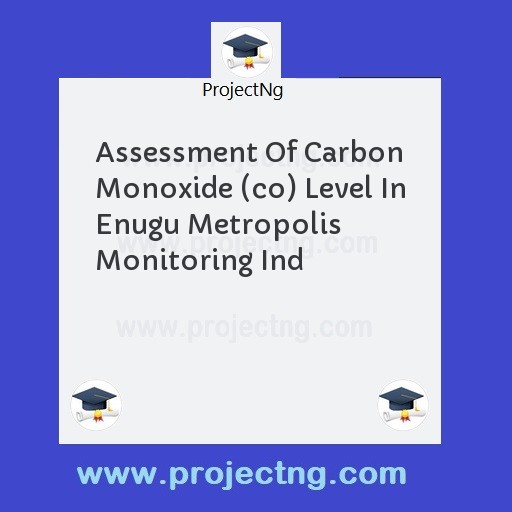Assessment Of Carbon Monoxide (co) Level In Enugu Metropolis Monitoring Ind
Chemical Engineering Project Topics
Get the Complete Project Materials Now! »
ASSESSMENT OF CARBON MONOXIDE (CO) LEVEL IN ENUGU METROPOLIS MONITORING IND
CHAPTER ONE
1.0 INTRODUCTION
Air pollution is associated with increasing cases of many adverse health effects, e.g. mortality, respiratory diseases and cancer. The chemical composition of ambient air is very complex and depends on many different factors, traffic generated air pollution being a major source in large cities. This is especially true in the developing world, mainly due to the high proportion of old, poorly maintained vehicles, the abundance of two stroke vehicles and the poor fuel quality (Baumbach et al., 1995; Gwilliam 2003). All these factors contribute to one of the major air pollutant in urban areas; carbon monoxide (CO).
CO is a poisonous, colorless, inevitable gas that has neither taste nor smell. It is formed when carbon burns with too little air (incomplete combustion) (Smith and Scott, 2002). Carbon monoxide (CO), also called Carbonious oxide or Carbon (II) Oxide and is slightly lighter than air. CO is a deadly, colorless, odorless, poisonous gas, produced by the incomplete burning of various fuels, including coal, wood, charcoal, oil, kerosene, propane, and natural gas. Products and equipments and machines powered by internal combustion engines such as portable generators, cars, lawn mowers, and power washers also produce CO. It has a high affinity for hemoglobin in blood and displaces O2 to form carboxyl hemoglobin (COHb). This can cause dizziness, headaches and eventually death. Tobacco smoke, gas
fires, burning candles are also common sources of CO in indoor air. Internal combustion engines are responsible for most of the CO in outdoor air (Smith and Scott, 2002). The ambient concentration of CO is measured in parts per million (ppm). Most of the studies on air pollution and exposure to air pollutants have been conducted in developed countries, i.e. Western Europe and the USA (Šišvić and Fugaš, 1987, Cernuschi et. al., 1998; and Chiara et. al., 2005). There is limited information on exposure to air pollutants in developing tropical countries, but some studies have been carried out in sub-Saharan Africa (Baumbach et. al., 1995; Fanou et. al., 2005; LindÑn e.t al., 2007).
The population in Enugu city, the economic and administrative capital of Enugu state, has increased rapidly in the last decade (about one million inhabitants), and in since there is no reliable public transport system, air pollution has worsened because of an increasing number of old second-hand cars and of taxi motorbikes (Keke-NAPEP). Petroleum products used are also of poor quality, due to the importation of sub-standard products into the country. No data on health effect of air pollution in Enugu city is available to the researcher, but it is anticipated that air pollution could become a major public health problem if adequate mitigation measures are not taken at this time. Exposure to air pollution is normally assessed by environmental monitoring; using either fixed monitoring stations or personal air collecting instruments.
Be the First to Share On Social

Enjoying our content?
Don't miss out on new videos! Subscribe to our YouTube channel for more awesome content.
Subscribe Now!













